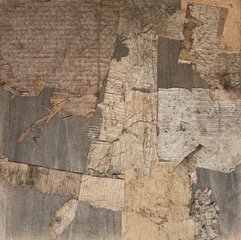This investigation began as a topological study of fragments of discarded cardboard found on morning walks with my dog. Left outside, these pieces of cardboard had been transformed by various physical processes acting on them. They bore little resemblance to the original monochromatic, rectilinear, and bundled state of newly manufactured cardboard. Once discarded cardboard breaks into smaller pieces which more closely resemble forms that occur in nature. Their sharp corners are softened, their flat surfaces curl and fold, their colors are change, and irregularities develop. To me they began to look more like their pre-factory origins. They began to look like parts of trees in a forest.
I began to study ways that the outdoor environment changes cardboard, assembling found cardboard fragments, then categorizing them according to physical processes such as tearing, fraying, and folding. The deformations that these scraps of cardboard have undergone suggested to me a yearning on their part to return to their origins of trees. This imagined yearning led me organize the fragments in grids of forms that resemble specific parts of trees, for example trunks, or branches.. Finally I began the collages that are “reconstruction” projects, arranging the cardboard fragments in ways that evoke memories of trees.
Intersections of the natural and the human built world are places that have always caught my attention: old buildings no longer protected from weather, weeds growing in the cracks of sidewalks, waves that have washed out a road. Human built things eventually return to a more nature ordered state.














